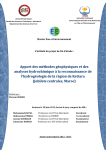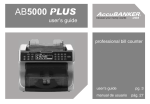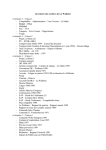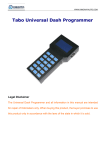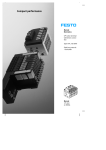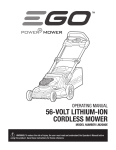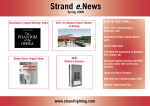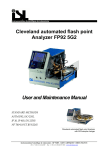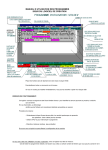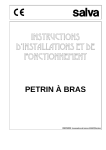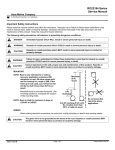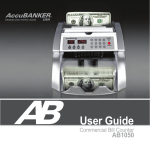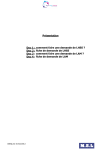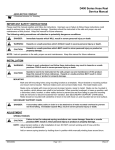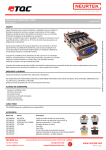Download AeroBar Systems Service Manual
Transcript
AeroBar Systems Service Manual Aero-Motive Company A Woodhead Industries, Inc. Subsidiary Important Safety Instructions Please read this manual carefully and follow its instructions. Improper use or failure to follow these instructions could result in serious injury, death or property damage. Operators should be instructed in the safe and proper use and maintenance of this product. Keep this manual for future reference. The following safety precautions call attention to potentially dangerous conditions. DANGER: Immediate hazards which WILL result in severe personal injury or death. WARNING: Hazards or unsafe practices which COULD result in severe personal injury or death. CAUTION: Hazards or unsafe practices, which MAY result in, minor personal injury or product or property damage. INSTALLATION WARNING: Failure to read, understand, and follow these instructions creates hazards that COULD result in personal injury or death. CAUTION: Instruct operators in the safe, proper use, and maintenance of system. Keep this manual for future reference. Hazards or unsafe practices MAY result in minor personal injury or product or property damage. WARNING: Installation should be performed by qualified electricians in accordance with the Canadian Electric Code or National Electric Code, any applicable state or local codes and any supplementary component labeling or instructions. WARNING: Ensure power is disconnected prior to beginning any work on the system. WARNING: Never force fingers or insert any foreign objects into conductor housing slot while the system is energized. INSPECT COMPONENTS Identify and inspect all systems components before installation. Make sure copper and housings are not damaged and are of correct quantity. Installation of damaged product may require system disassembly. INSTALLATION TOOLS These tools are not automatically included. Must be specified on order. SM6010-06B AB2000 AITCS AB5000 ABTT Pulling Block to help pull conductors in system. Copper Straightener to remove bend in AB125 or higher copper. Tom Thumb with wheels to assist in installing sealing strip on long systems. Tom Thumb without wheels to assist in installing sealing strips. Page 1 of 13 ©Aero-Motive Company Apr-03 AFC3 AITRC AB600K Copper Cassette to hold copper while pulling it in housing. Copper Holding Turntable for lengths of copper bigger than the AFC3 capacity. Copper End Forming Angle For making proper “L” shape bend at splice joints and end feed. POWER SOURCE CONNECTION All systems use either Line Feed or End Feed box for connection to power source. • Line Feed - Installation of feed box at any point along the housing. • End Feed – Installation at end of system • Multiple Feeds – Some system lengths require more than one box. Consult factory for proper installation details. STEP #1 - MOUNTING Sliding Hangers and Fixed-Point Clamps support housing. • Fixed Point Clamp - Rigidly fixes housing to support structure. System expands and contracts from this point. Install adjacent to power feeding box. Line feed uses one on either side of feed box. • Sliding Hanger – Allows housing to freely slide from fixed-point clamp as temperature changes. Install hangers every 5ft. (See diagram below). Fixed Point Clamp AB400K Sliding Hanger AB500K Joint Clamp AB300K End Feed Box ABEB Line Feed Box & Housing ABLB-80 or -160 End Cap AHBEC Housing x 10 ft. ABH10 END FEED LINE FEED Mounting supports must have slotted holes, or other provision, for horizontal adjustment to properly align system. If purchased, Universal Support Bracket is adjustable. Make sure supports are long enough for machinery to clear housing and feed box. NOTE: Horizontal sliding hanger adjustment must be provided by the mounting support (by customer). Install all sliding hanger brackets to mounting supports. Do not tighten top two nuts of mounting support until housings are in brackets. Final alignment adjustments require housings to be in place. SM6010-06B Page 2 of 13 ©Aero-Motive Company Apr-03 Housing alignment is critical. Hanger must not be cocked, or otherwise restrict free movement of housing through hanger. Sliding hanger comes with long bolt to allow vertical adjustment. Minimize distance between support and hanger. Optional Universal Support Bracket STEP #2 – SLIDE IN HOUSINGS WARNING: Proper alignment of system is critical. All housings must butt with each other before taping and clamping. Housings must follow an a parallel path to trolley tow arm. Important: systems up to 300 FPM must be within + one inch of trolley tow arm path. Install first housing. If end feed, housing is 10ft section. If line feed, single 5 ft. section with slots (clamp type), or two 2.5-ft sections with mating notched ends (splice type). Install feed box plate(s). Install fixed point clamp(s). Slide remaining housings into sliding hangers. All housings must have alignment stripe on same side. Align brackets as needed. All housings must meet at joints before installing tape. Failure to do this will require reinstallation of housings. On splice line feed do not install joining pins or top plate. Install only after pulling copper. NOTE: Install end collar pieces from line feed box or end feed box before mounting of housing. These parts are difficult to install as installation progresses. STEP #3 – TAPE AND CLAMP ALL JOINTS WARNING: AT50 tape must be used on all housing joints to maintain 600V rating. Joints must be taped with AT50 insulating tape after housings and feed sections are installed. Apply tape around entire housing, then cut opening for bottom slot. Tape must around bottom lip of housing Both Indoor and outdoor installations required this tape. NOTE: SM6010-06B Before installing joint clamp, make sure tape goes around lower housing lip to sealing strip slot. Page 3 of 13 ©Aero-Motive Company Apr-03 NOTE: Some systems require expansion joints to absorb housing expansion if movement is restricted or excessive. Tape and joint clamp are not used at some or all joints. See Special Components section: Expansion Joints. Place joint clamp halves under lip of housing and squeeze together top fins, install and tighten screws. Repeat for all housings. Check that joint clamp does not compress or spread housing’s opening. Opening “A” at bottom of housing should be about .39-.59 in. for trolley to freely pass. To fix, either squeeze clamps together, or twist a small flat piece of wood in housing to adjust gap. NOTE: Before installing conductors check inner trolley path. Insert trolley in housing and pull by hand through entire system, checking for restrictions to travel. This checks for alignment stripes on wrong side, housings with damaged internals, and locations where bottom slot constricts trolley travel. STEP #4 – PULL COPPER CONDUCTORS CONDUCTOR INSTALLATION First identify proper conductor locations based total number. NOTE: CAUTION: Trolley can enter housing only one way. Check that appropriate brushes will match your intended conductor locations. Conductors in any other configuration will cause premature trolley wear. Use copper cassette/turntable to hold conductor when pulling copper. Proper support of cassette is required; otherwise damage to conductor is possible during installation. Attach pulling block connector to conductor NOTE: SM6010-06B Check minimum towing angle of pulling block below. Page 4 of 13 ©Aero-Motive Company Apr-03 NOTE: Thicker AB125 and AB160 conductors require a copper straightener. Thread copper end though straightener before attaching pulling block. Straightener takes bend out of thick copper and assures easy pulling. End Feed All feed box plates must be installed prior to conductor installation. Pull conductors from end feed box end. NOTE: Copper bend at center of coil must face out at feed box end. Carefully choose which side to lay copper in cassette. See pulling diagram below. Line Feed – Clamp (Slotted Housing) Most Line feed systems use a 5-ft. line feed housing with slots and conductor clamps. Conductors may be pulled from either end of system. Position of copper bend is not critical since ends are cut off before installing end caps. Line Feed clamps at the feed box must be in position before pulling copper. They cannot be installed after copper is installed. Check to make sure copper slides through this clamp, and retains clamp before pulling copper to end. NOTE: SM6010-06B 125a copper has longer clamp plates. They must be installed with bus bar facing out to maintain 600v rating. No overlapping allowed. Page 5 of 13 ©Aero-Motive Company Apr-03 Line Feed – Splice Some line feed systems use a splice connection. A splice housing is two short 2.5 ft. sections with mating notched ends. Push sealing slot alignment pins completely into one housing. (After all copper is pulled and housings aligned, these pins are slid half into adjacent housing.) Remove one fixed-point clamp and pull housing to side so you can pull conductors like end feed. Copper bend at center of coil must face out at line feed box. Carefully choose which side to lay copper in cassette. See pulling diagram on previous page. The AB600K copper bending angle can be used to quickly make copper bend for splice feeds. Example: For AB125 use 125 hole. NOTE: File down wedges as required by copper thickness and install at joint, behind conductor, to align inside facing edges. After all conductors are installed in both directions, realign housing, attach fixed-point clamp, and tap alignment pins into place, install top bracket, and bolt conductors together. If using sealing strips, alignment pins do not allow engagement of strip. Trim back strip engagement edge (about 2 in.), and continue installing. SM6010-06B Page 6 of 13 ©Aero-Motive Company Apr-03 STEP #5 – MAKE REQUIRED CABLE CONNECTIONS WARNING: Fuse size must not be greater than maximum amperage capacity of system. Hazards or unsafe practices COULD result in severe personal injury or death. CONNECTING POWER SUPPLY Connect proper power supply cable though end plate to conductor connection bolts. Drill hole in end plate as needed for conduit connection. DO NOT OVER TIGHTEN bolts on line feed clamps. Connection screw may damage conductor and impact brush wear. The plate for end feed box is shown. If Line feed supply power connects directly to clamps or conductor splice. SEALING STRIPS (accessory) This item is supplied in a dual molded strip with both sides ready to install simultaneously. A thin web holds them together and is easily separated during installation. If splicing of strip is needed, use a Cyanoacrylate (Super/Krazy glue) to fix strip to housing at that point. Trim back lip at an angle so trolley does not catch strip edge. ABSS If strips are dry it is necessary to use a lubricant to aid in their installation Wipe mineral oil, or diluted siliconewater solution (20% silicone oil /80% water) on strip while installing. Two methods of installation. AB5000 HAND (short systems): Begin with end of sealing strip, insert into housing slot as shown. Engage rest of strip into slot with fingers. Leave extra on end for end cap(s). TOM THUMB – AB5000 and ABTT: Feed sealing strips through Tom Thumb and start into housing. Pull through system. Adjust pressing feet as needed on AB5000 only. ABTT STEP #6 – INSTALL TROLLEY AND TOW ARM INSTALLING TROLLEYS AND TOW ARMS Insert trolley into an open end of system, taking notice of small polarizing pilot guide on trolley. Trolleys can be inserted in only one direction according to anti-reverse slot. Carefully push in each brush until entire trolley is inside. Hand pull trolley through housing to make sure conductors are correctly installed, and joints at a line feed splice are smooth. If trolley catches on conductor joint, rework until transition is smooth. SM6010-06B Page 7 of 13 ©Aero-Motive Company Apr-03 To prolong brush life, and resist serious trolley wear, trolley must run in-line and without undue resistance throughout housing. • Cable loop must be generous, without any side pulling of trolley. • Tow arm chain connection point must be 3/8 to1-1/8 in. lower than trolley connection. • When pulling, the chain on the other side must have a little sag. See picture. • Tow arm tow chains must be adjusted for minimum side pulling of trolley. STEP #7 – INSTALL FEED BOX COVERS AND END CAP(S) INSTALLING END OR LINE FEED COVERS END FEED SYSTEMS – The Clamp plate is required to secure end feed collar to housing. Insert clamp plate assembly and push up against feed box plate before tightening. With gasket in place, fasten box cover to end plate collar. LINE FEED SYSTEMS – Insert gaskets in line feed box collar plates. Place line feed box cover between the two plates. Thread nut on one end of each threaded rod. Insert rods (with cap nut attached) into end sections, through cover and into opposite end collar plate. Align cover and securely tighten hardware. INSTALL END CAPS Trim all protruding conductors to 2 inches from housing end. Slide end cap over conductors and into each adjacent slot. Hold to housing and install insulating tape around joint to sealing strip slot. Install joint clamp and tighten all hardware. STEP #7 – FINAL CHECK Check These Items • Trolley is pulled in-line with system and cable pigtail is not affecting trolley posture. • Housings are aligned within required tolerance specified in step two. • No interference between feed boxes and equipment • Hard ware on all sliding hangers, fixed point clamps, and feed boxes is tightened. • Sliding hangers allow housing to freely slide as temperature changes. • Sealing strip, if installed, is engaged with slot along total length. • No squeezing or spreading of housings at joints or hangers. SM6010-06B Page 8 of 13 ©Aero-Motive Company Apr-03 SPECIAL SYSTEM COMPONENTS TRANSFER TRUMPET HOUSINGS (ABHT) NOTE: AeroBar transfer trumpets assemblies are made without the anti-reverse rib (no housing stripe) and can be installed on either end of system. Make sure trolley is installed properly to match main housing stripe. Trumpet Housing Trumpet transfers are mounted with a fixed point on either side of a line feed box. Trumpet end half of housing comes with 125amp copper installed. The other housing is attached to rest of system. Conductor joint is handled like a splice line feed (page 6). At splice joint conductors must be aligned for smoothest possible brush transition. Check with trolley. There is no stripe on the transfer housing so it is unpolarized and can be used at any transfer. Alignment ABHT trumpet transfers require horizontal and vertical alignment to be within .394”. Distance between trumpets can vary. Trolleys and Tow Arms Trumpet transfers require a spring loaded tow arm (ABTP) or a trolley tow bar pulled by chains. Multiple trolleys are commonly needed to maintain power during transfer. SM6010-06B Page 9 of 13 ©Aero-Motive Company Apr-03 Spring Loaded Tow Arm Must be separated by “X” distance to maintain brush contact on at least one or more trolleys during transfer. Tow bar Trolley (Special) Alternative to spring loaded tow arm is long bar pulled by chains. EXPANSION JOINTS (ABEJ) Expansion joints are used when housings are locked-in and unable to freely expand. Also are used if length of system and ambient change exceeds allowable limits. Rule #1: Any housing section with expansion joint must have a corresponding fixed-point clamp. Each fixed-point clamp replaces one sliding hanger, and section expands and contracts from this fixedpoint clamp into the expansion joint. A fixed-point clamp is included with each ABEJ. Rule #2: The ambient temperature range determines how many expansion joints are needed STEP #1 – Identify Type System Type #1 – End feed and Transfer on Opposite Ends. Expansion joints are needed on housing joints between the two feed boxes. Type #2 – Two Feed Boxes. Expansion joints are needed on housing joints between the two feed boxes. Type #3 – Long Systems Expansion joints are needed on part of system to reduce expansion to an acceptable range. Type #1 and #2 require copper to be bent and drilled to mate with adjoining copper end. Copper splice joint must be smooth. Use conductor wedges behind copper to assist in this process. Check splice with trolley before putting system into operation. (See page 6) SM6010-06B Page 10 of 13 ©Aero-Motive Company Apr-03 STEP #2 –Setting the Gap. WARNING: Proper gap at expansion joint is critical. Too much and trolley may not work properly. Too little and housing may deflect at high-end temperatures causing system damage. Make sure to properly insert the housing into expansion joint. Before installing adjacent fixed-point clamp, the gap at expansion joint must be set. Gaps are calculated based on the chart below. Maximum expected temperature and temperature at time of mounting determine the answer. A petroleum lubricant on sealing web inside the expansion joint may aid in installation. Set Gap according to chart intersection of maximum ambient (horizontal) and mounting temperature (diagonal). This chart is for use with expansion joints at every housing joint, every 10ft. If installing at 20 ft. (every other joint), then double Set Gap distance. Note: Maximum total gap not to exceed 1”. Example ABEJ every: 10ft Max Ambient: 104 F Mounting Temp: 50 F Then Set Gap: .27” or, If ABEJ every: 20ft Then Set Gap: .52” STEP #3 – Special Trolley Single gang ABT trolley is not allowed on expansion systems. Must use a double or triple ganged trolley. SM6010-06B Page 11 of 13 ©Aero-Motive Company Apr-03 INSPECTION UNIT (ABIU) WARNING AT50 tape must be used on all housing joints to maintain 600V rating. Inspection unit mounts at joint of two ABH housings. ABIU length is 8”: and is long enough to remove a single gang. If long system, the extra length of the ABIU might shift successive joint clamps too close to adjacent sliding hangers. If so, cut 8” from one ABH so overall housing length is not affected. Note: The inspection unit is not required to for inspection of trolley unless you have a closed loop system. Otherwise remove trolley from an end cap or end feed box end. ADJUSTMENT TROLLEY ALIGNMENT Critical to proper system operation is alignment of housing and trolley tow arm. If unusual wear is found on trolley, housings and towing may need adjustment. INSPECTION WARNING: Always disconnect electrical power before dismantling any part of system. Fuse size must not be greater than maximum amperage capacity of system. Hazards or unsafe practices COULD result in severe personal injury or death. TROLLEY • Check brush for any unusual wear grooves. • Check brush wear-line to edge of worn brush. • Check wheels for tight bearings and wear. • Check trolley neck, and body, for wear. • Check pigtail cable for side pulling. TOW ARM • Check tow chains and shackles for wear. • Check tow chain slack. Cannot be too tight. Chains must be long enough to allow for some side to side movement. • Check tow arm mounting and alignment with track. HOUSING • Check housing joints for secure grip between adjoining housing. • Check sliding hangers for free movement of housing. Tilted or cocked hangers must be aligned and tightened (see diagram). • Check housing bottom slot for consistent opening. Pinching by joint clamps or sliding hangers must be corrected to .39-.59 in. width. • Check support arms for stability. Must be horizontal and rigid. SM6010-06B Page 12 of 13 ©Aero-Motive Company Apr-03 SEALING STRIP • Check strip engagement over entire length. • Check condition for open seams, and wear. • Check trolley-neck wear caused by sealing strip. COPPER CONDUCTORS • Check for smooth surface. Uneven pulling force of trolley may indicate pitting. Gently spread housing and visually inspect conductors. MAINTENANCE TROLLEY Trolley brushes require changing as they approach brush wear line. Replace brush by removing retaining screw. Insert new brush, being very careful to place replacement brush over retaining spring and shunt wires into groves. Reinsert retaining screw and tighten. Push brush back and forth to check for free movement. REPLACEMENT PARTS Ref No. Part Number Qty. Description H44600051 2 Load Wheel Kit No Bearing (2 wheels, 1 shaft , 1 retainer) H44600041 2 Load Wheel Kit Ball Bearing (2 wheels, 1 shaft , 1 retainer) A B N7K91P 3-5 Trolley brush C R62400002 5.5’ 5c Cable D H11610006 2 C75540112 AR Right Angle Connector H44600001 2 Snap on Top Wheel Assembly No Bearing H44600011 2 Snap on Top Wheel Assembly Ball Bearing H44600021 2 Snap on Top Wheel w/ Side Roller No Bearing. H44600031 H18110026 2 AR Not Shown Aero-Motive Company A Woodhead Industries Inc. Subsidiary PO Box 2678 Kalamazoo, MI 49003-2678 USA (269) 337 7700 / (800) 999 8559 FAX: (800) 333 6119 www.aeromotive.com [email protected] SM6010-06B Tow Chain Snap on Top Wheel w/ Side Roller Ball Bearing. Trolley Connector Kit (tow plate and dovetail connection parts. Woodhead Connectivity LTD. A Woodhead Industries Inc. Subsidiary Factory No. 9 Rassau Industrial Estate Ebbw Vale Gwent NP23 5SD United Kingdom 44-1495-356300 FAX: 44-1495-356301 [email protected] Page 13 of 13 Woodhead Asia PTE LTD. A Woodhead Industries Inc. Subsidiary No. 4 Toh Tuck Link Level 3 Mezzanine Markono Logisitics Bldg. Singapore 596226 65-6-261-6533 FAX: 65-6-261-3588 [email protected] Woodhead Canada LTD. A Woodhead Industries Inc. Subsidiary 1090 Brevik Place Mississauga Ontario L4W 3Y5 Canada (905) 624-1079 FAX: (905) 624-9151 www.woodhead.ca ©Aero-Motive Company Apr-03














